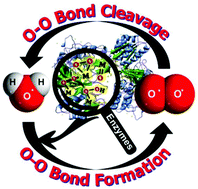Transition metal-mediated O–O bond formation and activation in chemistry and biology
Abstract
Oxygen evolution and reduction reactions are fundamental processes in biological energy conversion schemes, which represent an attractive method for artificial energy conversion for a world still largely depending on fossil fuels. A range of metalloenzymes achieve these challenging tasks in biology by activating water and dioxygen using cheap and abundant transition metals, such as iron, copper, and manganese. High-valent metal–oxo/oxyl, metal–superoxo, and/or metal–(hydro)peroxo species are common reactive intermediates that are found in the O–O bond formation and activation reactions. The transient nature of the metal–oxygen intermediates has, however, prevented their isolation and characterization in most cases. As a consequence, unambiguous mechanistic assignments in the O–O bond formation and cleavage processes in biological and chemical entries remain elusive, especially for the intermediates and mechanisms involved in the O–O bond formation reactions. This viewpoint article aims at summarizing the information obtained to date in enzymatic and biomimetic systems that fuels the debate regarding the nature of the active oxidants and the mechanistic uncertainties associated with the transition metal-mediated O–O bond formation and cleavage reactions.

- This article is part of the themed collection: Small molecule activation, from biocatalysis to artificial catalysis


 Please wait while we load your content...
Please wait while we load your content...